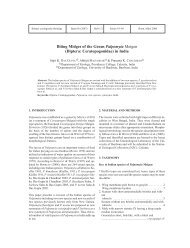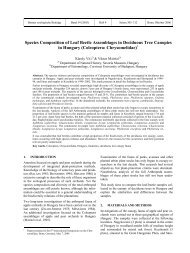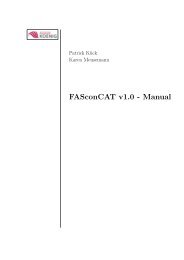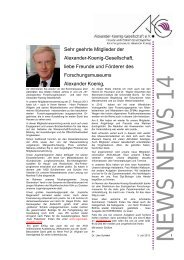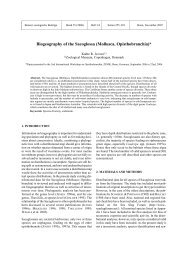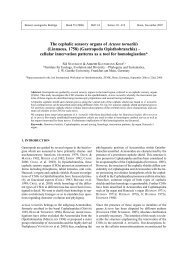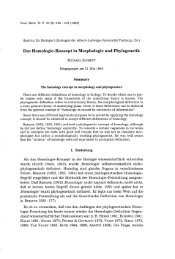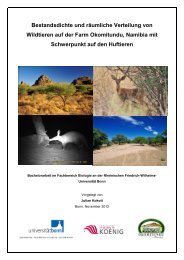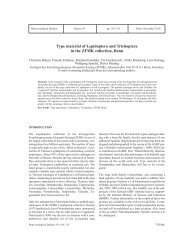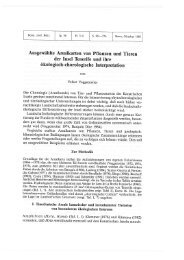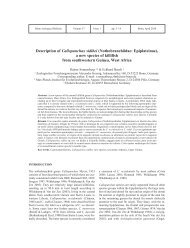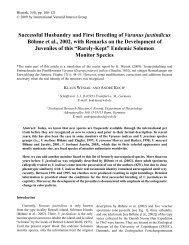Islands Between the Realms: A Revised Checklist of the ...
Islands Between the Realms: A Revised Checklist of the ...
Islands Between the Realms: A Revised Checklist of the ...
You also want an ePaper? Increase the reach of your titles
YUMPU automatically turns print PDFs into web optimized ePapers that Google loves.
116 André KOCH et al.: A <strong>Revised</strong> <strong>Checklist</strong> <strong>of</strong> <strong>the</strong> Herpet<strong>of</strong>auna <strong>of</strong> <strong>the</strong> Talaud Archipelago, Indonesia<br />
Lirung), Salibabu, coll. H. J. LAM 1926; ZMA 18409 (as<br />
Lygosoma triviale; 1 spec.), Beo, Karakelong, coll. M.<br />
WEBER 1899.<br />
Distribution & Taxonomy: The Talaud population was<br />
formerly recognized as E. cyanura (DE ROOIJ 1915; DE<br />
JONG 1928), which in contrast to E. caeruleocauda is<br />
widely distributed in Pacific islands from <strong>the</strong> Bismarck<br />
Archipelago eastwards (BROWN 1991). BROWN (1991) revised<br />
<strong>the</strong> genus and identified one specimen (MCZ 45774)<br />
from Karakelong as E. caeruleocauda.<br />
Fig. 10. Emoia a. atrocostata from Salibabu Island. Photo by<br />
André Koch.<br />
Distribution: According to BROWN (1991) <strong>the</strong> Talaud<br />
population <strong>of</strong> E. atrocostata belongs to <strong>the</strong> nominotypic<br />
subspecies. He examined one specimen from Karakelong<br />
(RMNH 18659). This coastal skink species is widespread<br />
ranging from <strong>the</strong> Philippines through <strong>the</strong> Indo-Australian<br />
Archipelago and many Pacific island groups such as <strong>the</strong><br />
Carolines and Palau reaching North Australia. This is <strong>the</strong><br />
first record <strong>of</strong> E. a. atrocostata for Salibabu Island.<br />
Ecology: The voucher (MZB Lac. 5130), a weak adult<br />
specimen infested with several red mites (Acari), was resting<br />
on coral limestone with temporary ponds at <strong>the</strong> shoreline<br />
where this species was frequently found on Salibabu<br />
Island (Fig. 2). Early activity was observed at 7 a. m. although<br />
<strong>the</strong> sky was cloudy and temperatures were relatively<br />
low.<br />
Morphology: SVL 85.4 mm, tail short, laterally compressed,<br />
73.6 mm long; TL/SVL 0.86; seven supralabials,<br />
fifth enlarged and below eye; tympanum small; lower eyelid<br />
with a transparent disk; one pair <strong>of</strong> nuchals; 38 midbody<br />
scale rows; 33 rounded lamellae under fourth toe.<br />
Emoia caeruleocauda (de Vis, 1892)<br />
Material examined: MZB Lac. 5114 (AK043), MZB<br />
Lac. 5115 (AK041), MZB Lac. 5118 (AK042), MZB<br />
Lac. 5127 (AK069).<br />
Additional material: MCZ 45774, coll. FAIRCHILD Expedition,<br />
1940; ZMA 18384 (1 spec.), Liroeng (= Lirung),<br />
Salibabu, coll. M. WEBER 1899; ZMA 18391 (as Lygosoma<br />
triviale; 2 spec.), Beo, Karakelong, coll. H. J. LAM<br />
1926; ZMA 18392 (as Lygosoma triviale; 5 spec.), Gunung<br />
Doeata (= Mt. Doata), Karakelong, coll. H. J. LAM<br />
1926; ZMA 18395 (as Lygosoma triviale), Liroeng (=<br />
Morphology: According to Brown (1991), <strong>the</strong>se phenetically<br />
similar species (E. cyanura and E. caeruleocauda)<br />
can be distinguished by <strong>the</strong> shape and number <strong>of</strong> lamellae<br />
under <strong>the</strong> fourth toe. Two specimens from Salibabu<br />
(MZB Lac. 5115, 5127) each had 44 lamellae under <strong>the</strong><br />
fourth toe, thus confirming <strong>the</strong> occurrence <strong>of</strong> E. caeruleocauda<br />
on <strong>the</strong> Talaud Archipelago. Lower eyelid with a<br />
transparent disk; hind limb reaches <strong>the</strong> axilla.<br />
Ecology: On Salibabu Island E. caeruleocauda was frequently<br />
found on <strong>the</strong> ground and low vegetation. It is <strong>the</strong><br />
most common lizard <strong>of</strong> <strong>the</strong> Talaud Archipelago. These<br />
conspicuous lizards use <strong>the</strong>ir metallic-blue tail fluttering<br />
from side to side to distract potential predators, mark male<br />
territories and attract potential mates.<br />
Eugongylus rufescens (Shaw, 1802)<br />
Material examined: none<br />
Additional material: ZMA 12491 (4 spec.), Gunung<br />
Doeata (= Mt. Duata), Karakelong, coll. H. J. LAM<br />
1926; ZMA 12492 (1 spec.), Lirung, Salibabu, coll. M.<br />
WEBER 1899<br />
Distribution: DE ROOIJ (1915) listed Eugongylus<br />
rufescens for Salibabu Island and DE JONG (1928) reported<br />
ano<strong>the</strong>r specimen <strong>of</strong> this skink from Karakelong (according<br />
to <strong>the</strong> online ZMA database 4 specimens are summarized<br />
under collection number ZMA 12491). We could<br />
not find this species during our field work. The Talaud<br />
populations represent <strong>the</strong> most north-western distribution<br />
<strong>of</strong> this short-legged skink which inhabits New Guinea, <strong>the</strong><br />
Solomon and Admirality <strong>Islands</strong> finally reaching nor<strong>the</strong>rn<br />
Australia.<br />
Eutropis m. multicarinata (Gray, 1845) (Fig. 11)<br />
Material examined: MZB Lac. 5084 (AK063), MZB<br />
Lac. 5085 (AK062), MZB Lac. 5087 (AK061), MZB<br />
Lac. 5116 (AK060), MZB Lac. 5117 (AK058).




